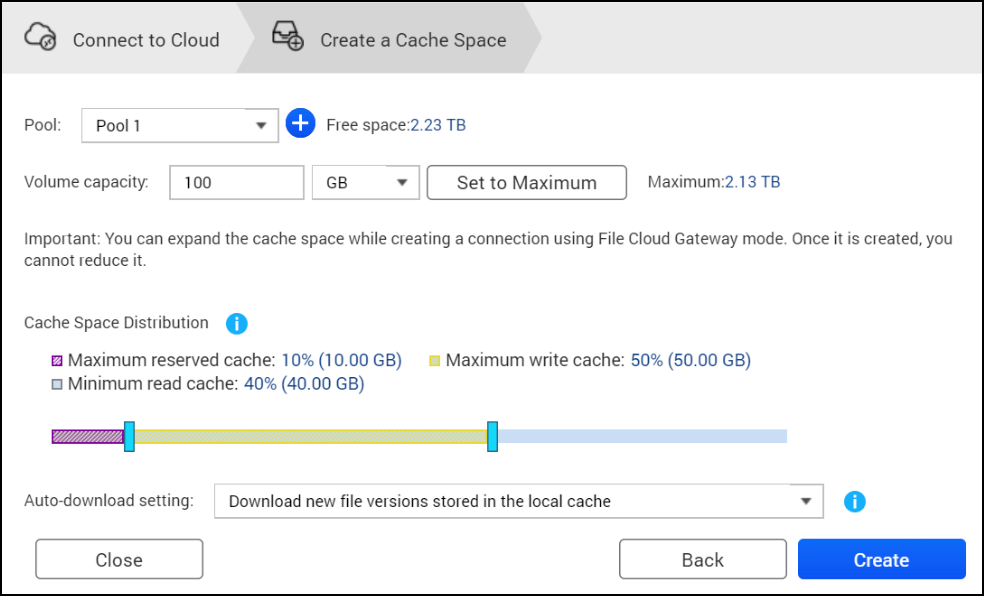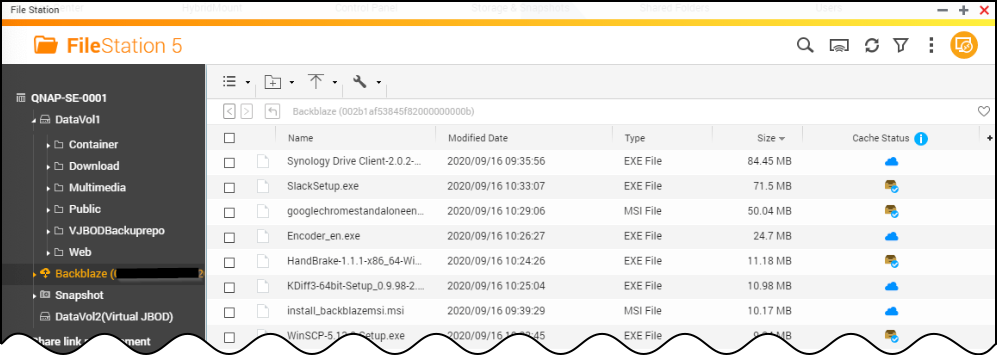- Print
- DarkLight
QNAP HybridMount Integration with Backblaze B2
- Print
- DarkLight
With Backblaze B2 Cloud Storage and QNAP HybridMount, using Cloud Gateway (caching) mode, all of your QNAP apps can access your cloud storage as if it is local.
Enable Backblaze B2
Before you begin: You must have a Backblaze B2 Cloud Storage account. If you already have a Backblaze account and the left navigation menu contains a B2 Cloud Storage section, your account is already enabled for Backblaze B2.
- Sign in to the Backblaze web console.
- In the user menu in the upper-right corner of the page, select My Settings.
- Under Enabled Products, select the checkbox to enable B2 Cloud Storage.
- Review the Terms and Conditions, and click OK to accept them.
Create a Bucket
- Sign in to the Backblaze web console.
- In the left navigation menu under B2 Cloud Storage, click Buckets.
- Click Create a Bucket.
- Enter a name for your bucket. Bucket names must be at least six characters and globally unique.
A message is displayed if your bucket name is already in use. - Select a privacy setting: Private or Public.NoteYou can change a bucket's privacy settings at any time.
Files that are in a private bucket require authentication to perform an action, for example, downloading.
Public buckets do not require authentication so you can easily access files. If this is your first time creating a public bucket, complete the following tasks to ensure that you have the correct permissions to create a public bucket:
1. Verify your email address.
2. Have a payment history on file, or use the credit card form to pay a small fee that is credited to your account balance. - If applicable, enable a Backblaze B2 server-side encryption key.
- Enable Object Lock to restrict a file from being modified or deleted for a specified period of time.
- Click Create a Bucket, and copy the value that is in the Endpoint field; you may need this value later.
- Click Lifecycle Settings to control how long to keep the files in your new bucket.
Create an Application Key
- Sign in to the Backblaze web console.
- In the left navigation menu under B2 Cloud Storage, click Application Keys.
- Click Add a New Application Key, and enter an app key name.
You cannot search an app key by this name; therefore, app key names are not required to be globally unique. Key names are limited to 100 characters and can contain letters, numbers, and "-", but not I18N characters, such as é, à, and ü. - Select All or select a specific bucket in the Allow Access to Bucket(s) menu.
- Optionally, select your access type (Read and Write, Read Only, or Write Only).
- Optionally, select Allow List All Bucket Names.
This option is required for the B2 Native API b2_list_buckets and the S3-Compatible API S3 List Buckets operations. - Optionally, enter a file name prefix to restrict application key access only to files with that prefix.
Depending on what you selected in step #4, this limits application key access to files with the specified prefix for all buckets or just the selected bucket. - Optionally, enter a positive integer to limit the time, in seconds, before the application key expires.
The value must be less than 1000 days (in seconds). - Click Create New Key, and note the resulting keyID and applicationKey values.
Connect a Backblaze B2 Bucket in QNAP HybridMount
Before you begin: You must download and install QNAP HybridMount. The first time that you open QNAP HybridMount, you should review the quick-start guide.

- Open QNAP HybridMount, and click Create File Cloud Gateway in the Cache Space section.
- Select Backblaze as the cloud service.
- Enter your application key ID in the Account field, and enter your application key in the API key field.
- Select Validate SSL certificate.
- Click Search next to Bucket name.
A list of your buckets is downloaded, and you can select a bucket from the dropdown menu. This may take up to 60 seconds to populate. - Enter a connection name, for example, Backblaze B2.
- Select the policy when you upload files.
- If multiple users use the QNAP, select Check for conflicts and rename local files.
- If there is only one QNAP user, select Upload files without checking for faster performance.
- Select the frequency to check for changed files, and click Next.
By default, this occurs every six (6) minutes every day of the week.
Create a Cache Space

- Select the pool in which to create the cache, and (if desired) increase the size of the cache above the minimum.
- Review the auto-download setting, and adjust it to fit your needs.
- Click Create.
View a Mounted Bucket in File Station
You can access cloud files in the File Station and protocols such as SMB, NFS, AFP, and FTP. You can also manage this connection and apply the Always keep in reserved cache setting to important folders in Mount Management.

Open File Station to view the Backblaze mount point (with its account ID) and a list of all of the files in the bucket.
In the right column, the cloud status is displayed. At first, every file has a (cloud) icon that means that the file has not been cached. As the files are accessed on the QNAP, and they are downloaded and cached, the
(cloud) icon that means that the file has not been cached. As the files are accessed on the QNAP, and they are downloaded and cached, the (file) icon changes.
(file) icon changes.
Review your usage and adjust the cache size as needed based on your usage and available disk space.
